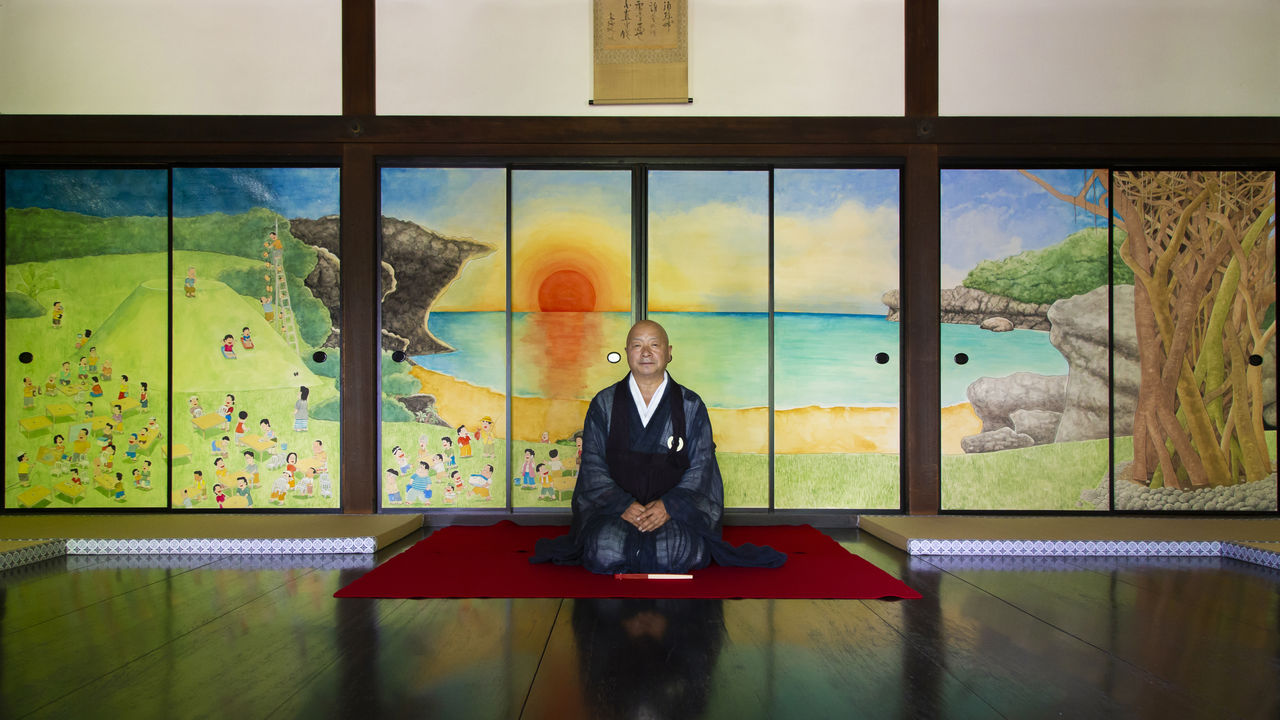
New Art in an Old Setting: The Shinjuan Painting Project at Daitokuji, Kyoto
Guideto Japan
- English
- 日本語
- 简体字
- 繁體字
- Français
- Español
- العربية
- Русский
At Ikkyū’s Temple, Anything Goes
Shinjuan is associated with Ikkyū Sōjun (1394–1481), a Zen Buddhist monk whom many Japanese know thanks mainly to a TV cartoon series aired in the 1970s that depicted him as a sassy, sharp-witted young boy who made quick work of solving Zen riddles along with people’s problems in real life. In fact, Ikkyū was a high-ranking monk and founder of the Rinzai sect’s Daitokuji complex. The project in question will create new paintings to accompany the originals on the fusuma, or sliding doors, at Shinjuan, one of Daitokuji’s subtemples that once served as a residence for monks.
 The garden at Shinjuan is designated a scenic historic site.
The garden at Shinjuan is designated a scenic historic site.
The fusuma in the rooms of the main hall at Shinjuan are decorated with ink brush paintings by Soga Jasoku, a painter of the late Muromachi period (1333–1568), who is said to have studied Zen under Ikkyū, and Hasegawa Tōhaku, a leading artist of the Momoyama period (1568–1603). The paintings, which are by now between 400 and 500 years old, have become damaged with the passage of time, and an eight-year project was begun in 2015 to refurbish the doors, restoring the damaged old masterpieces. The temple authorities decided to approach contemporary artists and commission all-new paintings for sliding doors where there were gaps in the extant artwork.
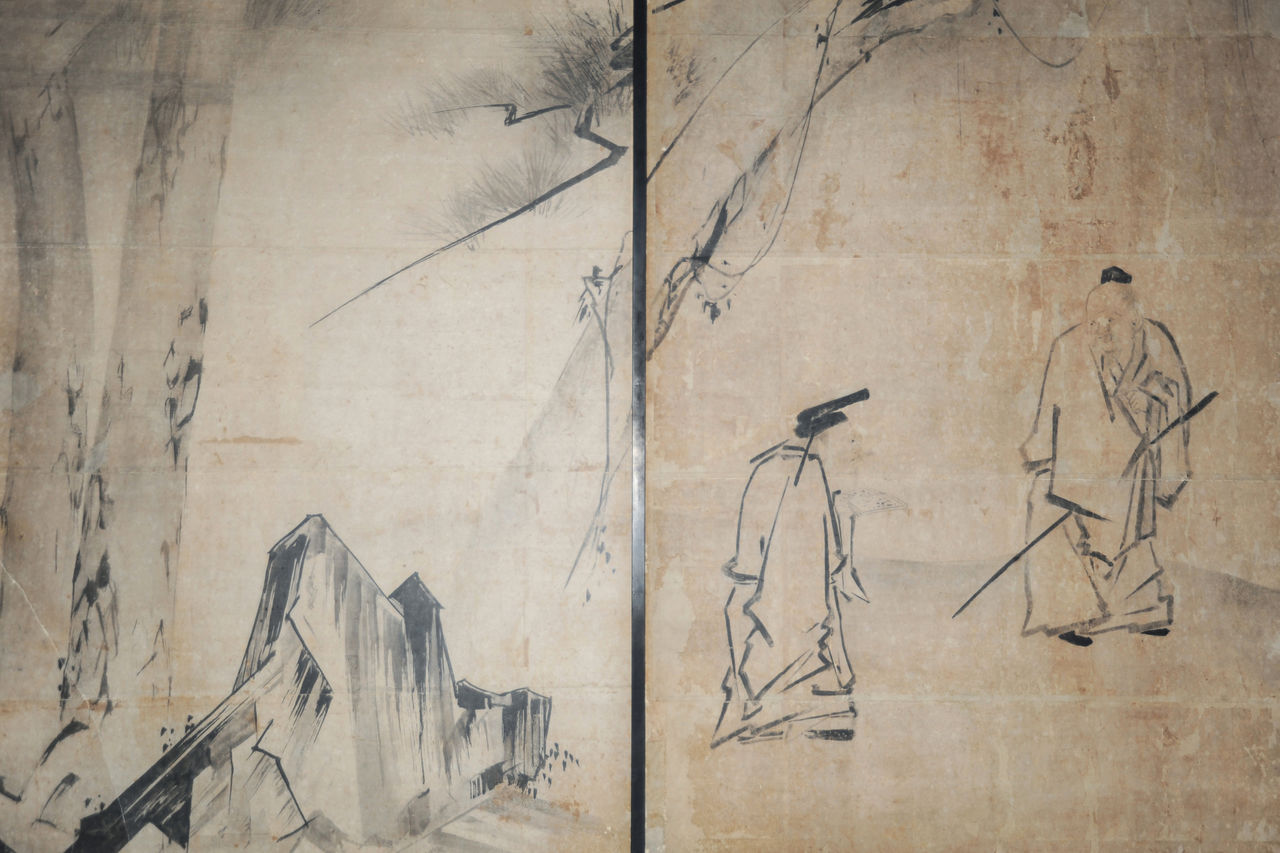 A fusuma painting by Hasegawa Tōhaku under restoration. (Photo courtesy of Shinjuan.)
A fusuma painting by Hasegawa Tōhaku under restoration. (Photo courtesy of Shinjuan.)
Six artists were chosen for the project, including manga artist Kitami Ken’ichi of Tsuribaka nisshi (Fishing Fool’s Diary) fame; Yamaga Hiroyuki, principal of Gainax, producer of Neon Genesis Evangelion, an anime television series from the 1990s featuring biomachines; and video game Final Fantasy art director Kamikokuryō Isamu. There is little connection between manga, anime, or video games and Buddhist iconology, but just as Ikkyū was an unconventional figure in his time, so Daitokuji head priest Yamada Sōshō believes that at Ikkyū’s temple, “anything goes.”
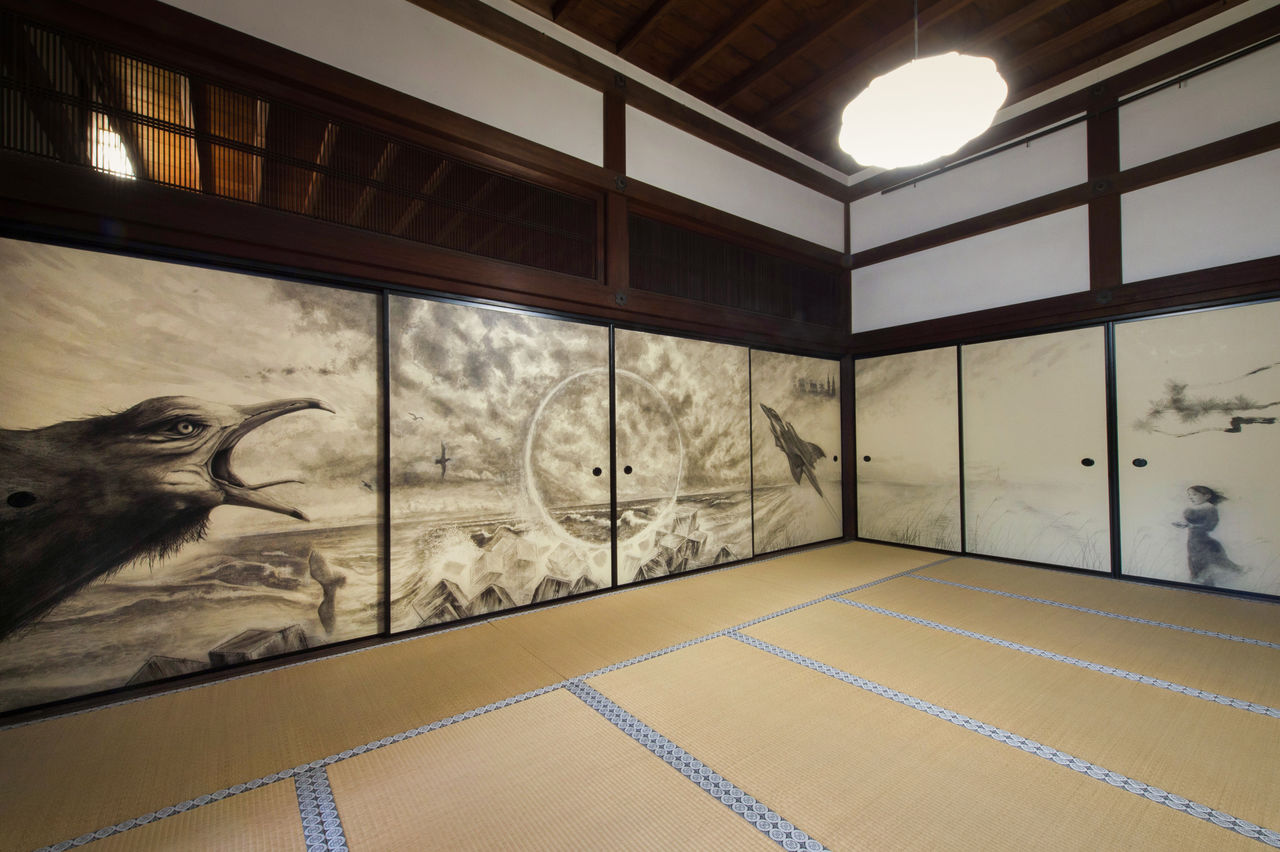 In the Danna no Ma room of Shinjuan’s main hall, a work by Yamaga Hiroyuki has replaced the ink brush paintings of Hasegawa Tōhaku.
In the Danna no Ma room of Shinjuan’s main hall, a work by Yamaga Hiroyuki has replaced the ink brush paintings of Hasegawa Tōhaku.
Since the restoration of an Important Cultural Property of this kind is so costly, the general public will be admitted to see the fusuma works for a limited period—from September 1 to December 16 this year—and the admission fee charged will be used to defray part of the project’s cost. A crowdfunding appeal is also underway to help support the project. And in conjunction with this special viewing, other parts of Shinjuan normally not open to the public can be visited at the same time. These include the Tsūsen’in study, the Teigyokuken tea ceremony room said to have been designed by Ikkyū’s contemporary, tea master Murata Jukō, the traditional karesansui-style garden Shichi-Go-San no Niwa, and others.
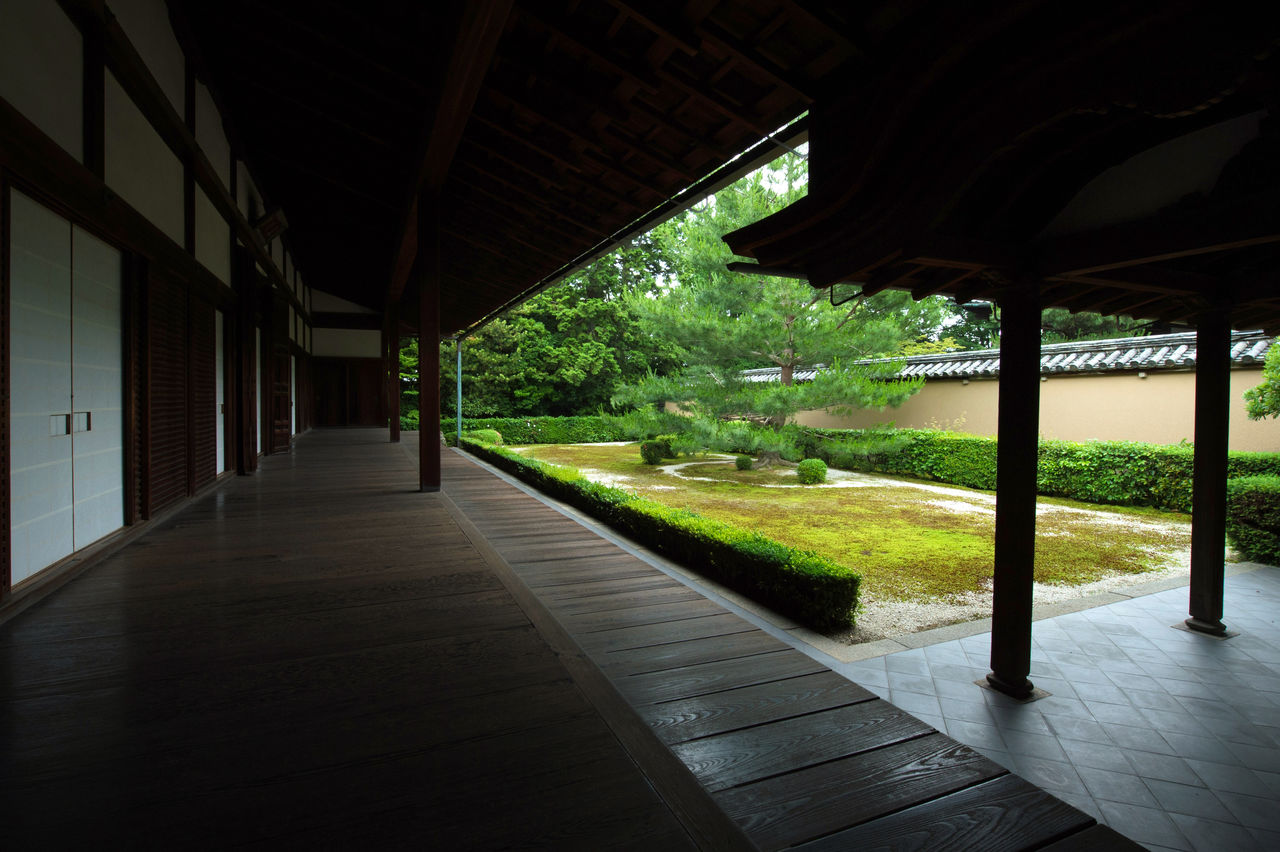 The south Hōjō garden adjacent to the Main Hall.
The south Hōjō garden adjacent to the Main Hall.
Seeing the Artists in Action Up Close
I’m a budding cinematographer who has been living at Shinjuan as an apprentice. The main work of temple apprentices is keeping the garden spotless, but as someone who is just starting out in my profession, I found it a stimulating experience to have a close-up view of today’s leading popular artists at work.
The temple day starts early. By 6:00 in the morning the abbot is already chanting sutras, and the apprentices have finished cleaning the garden and are preparing breakfast. Meanwhile, the artists follow their own routines: some of them start working as soon as they wake up, while others may take part in a Zen session with the abbot in order to center themselves.
At nightfall, the evening meal is prepared and the artists gather to enjoy the fantastic food prepared by the priests in charge of the kitchen. With such an elite group of artists at the table, you would expect tension in the air, but everyone is relaxed and the meal takes place in a friendly, familylike atmosphere. Drinks are poured around and the mood is merry, but the party breaks up on the stroke of 11:00 and everyone calls it a night.
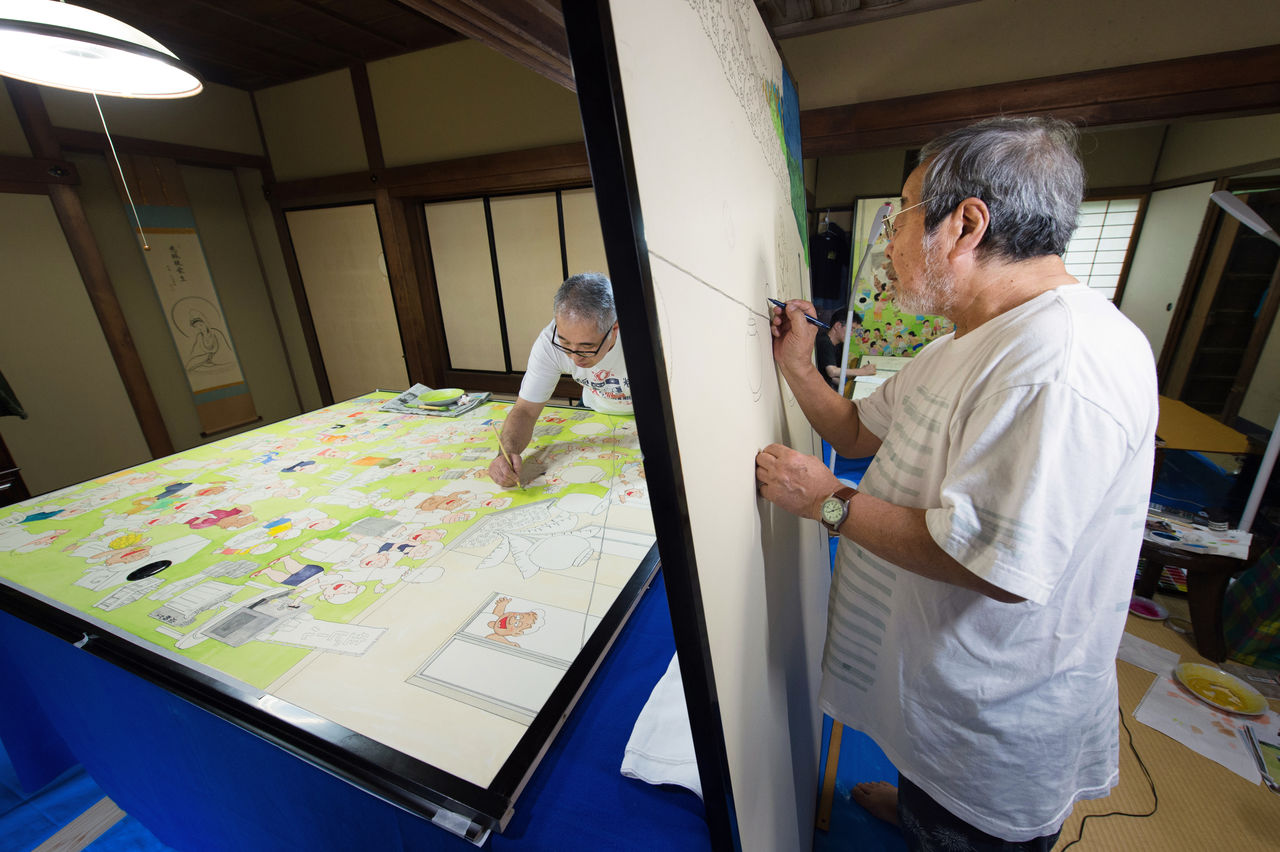 Kitami Ken’ichi (right) and his assistant at work.
Kitami Ken’ichi (right) and his assistant at work.
Zero Is Infinity
The conversation at the table can be engrossing. I was struck particularly by Kamikokuryō Isamu’s remark that “you know, zero can be likened to infinity.” Whereas the artists on this project are donating their work, they usually work on a deadline and receive a fee commensurate to the value of their creations. Since there’s no “end point” in the form of a payment for this project, it’s up to the artist to decide when the work is done. I wondered what Kamikokuryō meant by his “infinity” remark, but it later came to me that he was saying that a work with no price attached is infinitely more valuable than any work for which the artist may have been paid a substantial fee.
Due to his busy schedule producing serialized manga, Kitami Ken’ichi traveled numerous times to Shinjuan to work on his creation. Its theme is a banquet taking place at his holiday home, on the island of Yoron south of Kyūshū, and it features some of the characters from his manga. “I just keep adding more and more of them to my drawing. I can’t help it! I hope I’ll be finished in time for the public viewing,” he exclaims dramatically, but the broad grin on his face communicates the glee he feels at being part of the project.
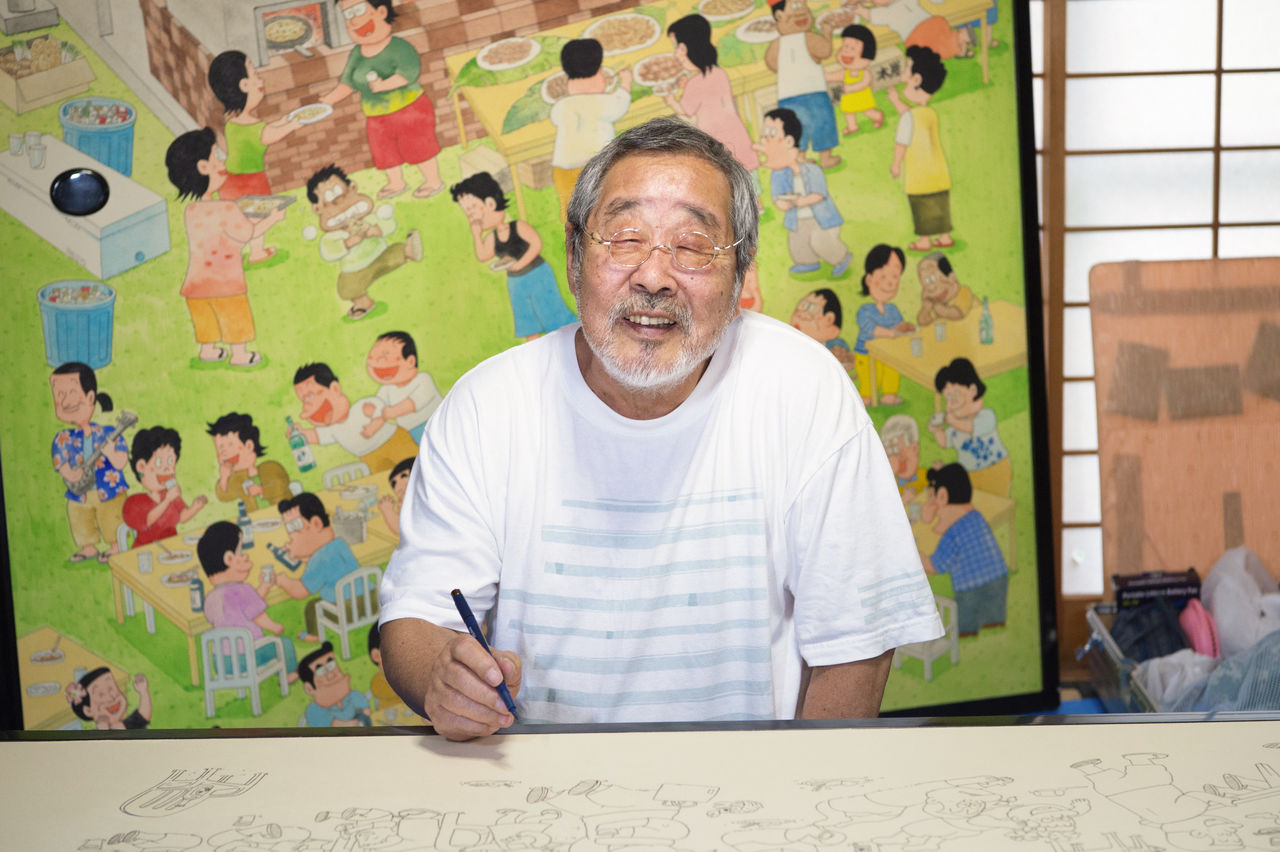 Kitami Ken’ichi, hard at work but enjoying every moment.
Kitami Ken’ichi, hard at work but enjoying every moment.
Continuity in the New Paintings
Work on the new fusuma paintings began in the fall of 2017. The six artists gave their all to the work, and they left Shinjuan one by one after completing their assigned portion. As if to make up for the stillness left by their absence, this year’s summer heat began to envelop everything in a steamy haze.
Kitami’s “Paradise” decorates the fusuma in the center room of the main hall, flanked by the works of Yamaga on the right and Kamikokuryō on the left, which depict the present and the Pure Land, respectively. When the three rooms are opened to each other, it seems not merely coincidental that the works unfold just like a picture scroll detailing the artists’ conceptions of life and death. Kamikokuryō appeared deeply moved as he remarked that “this kind of outcome is definitely Ikkyū’s doing.”
 There is continuity of expression when the fusuma paintings by Kamikokuryō and Kitami are viewed side by side.
There is continuity of expression when the fusuma paintings by Kamikokuryō and Kitami are viewed side by side.
The new paintings are not just for the enjoyment of people here today. They are for future generations as well, and will likely, in time, become classics. Just as the works of Jasoku and Tōhaku communicated the mores, ideas, and culture of their times, so will the new fusuma paintings convey the spirit of the twenty-first century to people hundreds of years from now.
This special viewing is a rare opportunity to be part of a historic experience, and I hope that it will attract many visitors.
Daitokuji Shinjuan Special Viewing
- Dates: September 1 to December 16, 2018 (closed October 19–21)
- Hours: 9:30 am to 4:00 pm (last entry)
- Fee: Adults ¥1,200, junior high and high school students ¥600, ages 12 and under free (when accompanied by an adult). Note: preschool age children will not be admitted to the Tsūsen’in study or the Teigyokuken tea ceremony room.
- Access: from Kyoto station, take the Kyoto municipal subway Karasuma line to Kitaōji. Transfer there to Kyoto city bus routes 1, 101, 102, 204, 205 or 206 and get off at Daitokuji-mae. From there, 7 minutes on foot (total travel time about 35 minutes).
- Daitokuji Shinjuan special viewing website
- Crowdfunding website for Kyoto Shinjuan (Japanese language only)
(Originally published in Japanese. Reporting and text by Tsunoda Ryūichi. Photographs by Kuroiwa Masakazu, Shinjuan, and Nippon.com. Banner photo: Daitokuji head priest Yamada Sōshō poses with some new additions to Shinjuan’s collection of painted doors.)
